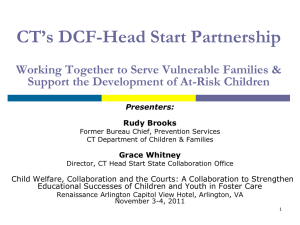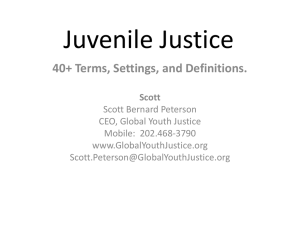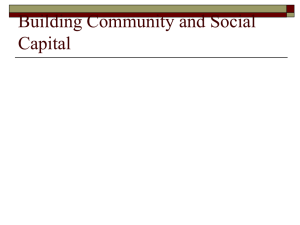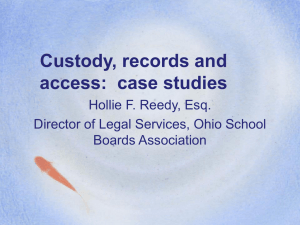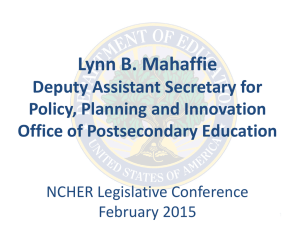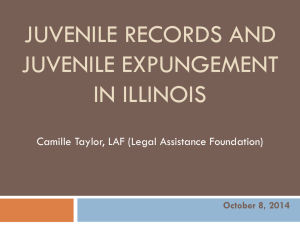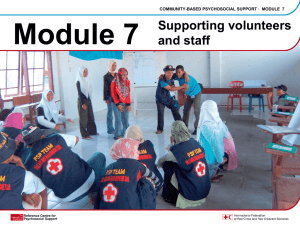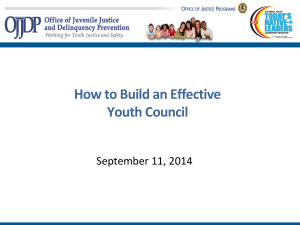DCF Presentation on FACES bill_SWAC
advertisement
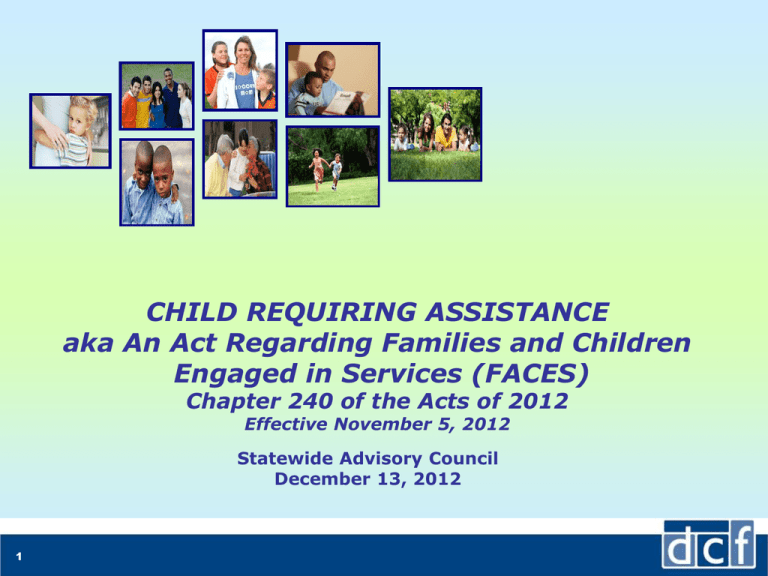
CHILD REQUIRING ASSISTANCE aka An Act Regarding Families and Children Engaged in Services (FACES) Chapter 240 of the Acts of 2012 Effective November 5, 2012 Statewide Advisory Council December 13, 2012 1 OVERVIEW OF CHANGES • Creation of a Community Based Services Network to provide services to Children Requiring Assistance • Establishment of a Family and Children Requiring Assistance Advisory Board • Makes Changes to the current “CHINS” law • Additional Requirements for DESE 2 COMMUNITY BASED SERVICES NETWORK • The Secretary of Health and Human Services must establish a comprehensive and integrated network of child and family service programs and family resource centers (the network) throughout the commonwealth to provide communitybased services for families with children requiring assistance (Chapter 6A, section 16U) 3 Community Based Services Network • Purpose of Services: – (i) assist families so that, whenever possible, children may continue residing with their families in their home communities; – (ii) assist families to enable children to continue as students in their community schools; – (iii) strengthen the relationships between children and their families; and – (iv) provide coordinated, comprehensive, communitybased services for children at risk of dropping out of school, committing delinquent acts or engaging in behaviors which impede the likelihood of leading healthy, productive lives. 4 Community Based Services Network • • • • • • • 5 Develop guidelines and standards to achieve and maintain the integrated network. Require the use of standardize intake screening and assessment tools used by the community-based service network to evaluate families and children. Coordinate the services provided by the network. Encourage cooperation among local providers to provide the services provided by the network. Monitor and provide technical assistance to the network Promote efficiency and access to existing services in establishing the network by including: organizations that are part of the comprehensive community–based behavioral health delivery system coordinated by the secretary under section 16S; organizations that provide services or have experience in coordinating access to community-based services such as local schools; other local public agencies, private organizations, or medical or mental health care providers. Create a data collection system for use by the community-based service network Community Based Services Network • The services are to include treatment for or assistance with: eligibility determinations, behavioral, medical and mental health needs, special education evaluation, remedial education services, assistance with insurance issues, mentoring, family and parent support, civic engagement and community service, after school and out-of-school opportunities, residential programs, crisis management and case management. 6 COMMUNITY BASED SERVICES NETWORK The establishment of the network would be under the following timelines: – Design a pilot program, with the advise of the board, within 1 year from the effective date (Nov 5, 2012). This is not subject to appropriation.) – Subject to appropriation, implement a pilot program and establish pilot family resource centers or a community-based service system program in each county of the state (total of 14) within two (2) years from the effective date of the act. – Subject to appropriation or third party reimbursement, implement the entire system, within three (3) years from the effective date of the act. 7 Community Based Services Network • Documentation of the services and information provided by the families will be confidential • Except as provided by law, statements made while receiving services are also confidential and may not be used in any proceedings without written consent of the person. • Provides for the sharing of information, subject to federal law limitations, among the case team, the providers of services and agencies within EOHHS providing services to the family for the coordination of services and case management unless the family specifically declines such use. • Participation in services will be voluntary, but can be subject to payment or allowing their insurance to be billed for the services. [MGL c 6A, sec 16U(d)] 8 Family and Children Requiring Assistance Advisory Board 9 • The law establishes a Family and Children Requiring Assistance Advisory Board to assist and advise the Secretary on the development and implementation of the community-based service network and to monitor the progress. The board is within, but not subject to EOHHS. • The board must be established within 30 days of the passage of the law and the first meeting must to be held within 60 days. • The Governor and the Chief Justice of the Juvenile Court designate 1 board member each to serve as co-chairs of the board. (Board consists of approximately 20 members.) Family and Children Requiring Assistance Advisory Board • 1 member appointed by Speaker of House • 1 member appointed by President of Senate • 1 member appointed by Minority leader of House and 1 by minority leader of Senate • 5 members appointed by governor: – DA, independent education advocate, private provider of children’s behavioral health services, parent who is not a Commonwealth employee, member municipal police 10 Family and Children Requiring Assistance Advisory Board • Commissioners DCF, DYS, DMH, DPH, DESE, • Director Office of Medicaid • Child Advocate • DCF Adolescent SW approved Pilot RD • DMH Case Manager Approved Pilot RD • Juvenile Judge and Probation officer • Chair of CPCS Board 11 Family and Children Requiring Assistance Advisory Board In addition to advising and monitoring, the board is charged with the specific tasks of proving a mechanism for the clerk of the juvenile court to obtain certain information deemed necessary to assist with providing services and evaluating the programs and make referrals to the community-based services network and to coordinate with the probation department to obtain specific data from the juvenile courts where the pilot programs are established. The Board must also be kept informed of the probation department’s development of a data collecting system and of the juvenile court’s effectiveness in providing assistance to children and families who seek or are subject to assistance. 12 Changes to CHINS Law • Changes the name of the population to “Child Requiring Assistance” • Increases the age of filing up to 18 from 17 years old. However, a dispositional order cannot continue to be effective after 16 for if School (truancy, fails to obey school rules) files and after 18 if parent/guardian/custodian file (runaway, refuses to obey rules at home). • Add definitions to Chapter 119, section 21: – “family requiring assistance”: a parent, guardian, custodian, sibling and any relative or caretaker responsible for a child requiring assistance. – “habitually truant”: a school-aged child, not excused from attendance under the lawful and reasonable regulations of such child’s school, who willfully fails to attend school for more than 8 school days in a quarter. 13 Changes to CHINS Law • Restricts information from proceedings under this law from being entered into the criminal offender record information system. • Limits the retention of a record of an application for assistance after the application is dismissed. (sec. 39E) • Requires the expungement of any records of the request for assistance and related proceedings which is dismissed prior to accepting the application for assistance. ( Sec. 39E) • Police officer cannot file a CRA petition for a runaway however, a parent, legal guardian, or custodian with custody of the child may file. (Sec 39E) 14 Changes to CHINS Law • Expands from “supervisor of attendance” to “a school district” the person authorized to file an application for assistance for a child who is habitually truant or child who fails to obey the lawful and reasonable rules of the school. (Sec 39E) • At the time of filing, the school will be required to state what steps have been taken to prevent the child’s truancy, including any participation in a truancy prevention program (If available), and to improve a child’s conduct who is not obeying the school’s rules. 15 Changes to CHINS Law 16 • The clerk of the juvenile court will be required to inform the petitioner that they can delay the filing of the application, choose to be referred to a community-based services program, a family resource center or other entity designated by EOHHS to provide community-based services in the court district where the child lives and return to the court later if needed. • The clerk of the juvenile court is also required to prepare, publish, and provide informational material to the petitioner on the availability of the community-based services. • If the petitioner is a parent, legal guardian or custody the clerk must provide the petitioner with information on the court process, the types of orders that may issue, including custody changes, and an explanation of the services available through the court process. • The Commissioner of Probation to required to establish a data collection system for requests for assistance, which includes data on any referrals to public or private organizations for services. Changes to CHINS Law Time Frame Changes: – From filing the request to the preliminary hearing: No later than 15 days after filing request (current law no time frame, Juvenile Court Time standards was 90 days) – Time for Informal Assistance (by Probation generally) 90 Days from filing request with one 90 day extension (Current Law 6 months with 6 month extension) 17 Changes to CHINS Law Time Frame Changes: – Time to Hearing on the Merits: No time limit in law (Juvenile Court Time Standards require within 6 months of petition issuing) – Dispositional Orders: First order 120 days with no more than three(3) 90 day extensions. [390 days] (Current 6 months with 6 month extensions, not time limited). 18 Implementation Issues • Clerk Magistrate’s level – time reduction from 90 days to 15 days. Been used for diversion efforts • Cases that are Pre-Adjudication: Continue from stage of case using the new time frames and processes. 19 Implementation Issues • Cases that are Post-adjudication: – If the disposition order is 390 days or older the case will be dismissed. – If the child is in DCF custody and the court ordered custody is over 390 days, case (and custody) will be dismissed. – If custody order is less than 390, court can extend in 90 day increments but not more than the total being 390 days (unless disposition has reached 390 days) 20 Implementation Issues • Children who need to remain in placement: – 1. Take a VPA from the parent and file a section 23(a)(1) petition in Probate Court – 2. File a Care and Protection in Juvenile Court if the parent is not involved or otherwise is not properly caring for the child • Going forward – limit on CRA disposition timeframe, including custody order so same issues will occur if child needs to remain in placement after the 390th day of dispositon. 21 Changes to CHINS Law • The parent, guardian or custodian will have an opportunity to be heard at the hearing on the merits. • • The petitioner or any party may file a motion to dismiss prior to the time for the hearing on the merits. (Section 39G) • A copy of the application for assistance and the notice of any hearing must be provided to child’s counsel. (Section 39F) • A parent has the right to counsel in any hearing or proceeding where custody is an issue. This right was established by a Supreme Judicial Court decision, In the Matter of Hilary, 450 Mass. 491 (2008). This section adds to the statute the right provided by that decision. (Section 39F) 22 Changes to CHINS Law • The provision for bail has been eliminated. • In its place: If the court finds the child is not likely to appear at a fact finding or dispositional hearing, the child can be released with conditions or can be placed in the temporary custody of DCF. • Prior to placing a child in the temporary custody of DCF, the court must make a written certification that it is contrary to the best interest of the child to be home and that DCF has used reasonable efforts to prevent removal from the home, or that there is an immediate risk that prevents DCF from using efforts to prevent removing the child from his/her home. • The temporary custody order is only valid for 15 days without a further hearing but can be extended for 15 day periods up to 45 days. Section 39H 23 Changes to CHINS Law • If the court finds that a child requires assistance, the court shall convene a conference to determine the most effective assistance available to be offered the family and child. • The participants of the conference include the probation officer, the petitioner, a representative from the child’s school, the parent/guardian or custodian, the child and child’s attorney, a representative of the community-based services if involved with the family, a representative of DCF if involved with the family and any other person who may help in determining the treatment and services for the child and family. • The probation officer shall and others at the conference may present recommendations to the court and present evidence on the best disposition, including the child and parents. • The dispositional options remain unchanged from the current law. 24 Disposition Options • Dismissal • Child remains with parent/guardian, subject to conditions and limitations • Child placed in custody of third party, subject to conditions and limitations • Child placed in DCF custody, subject to conditions and limitations AND Court must make the written certifications required by c. 119 sec 29C (CTW/Reasonable Efforts) 25 Changes to CHINS Law • The words “arrest” are changed to “custodial protection”. • A police officer may take into “custodian protection” but not arrest a child for engaging in the behaviors that fall under CRA if the child fails to respond to a court summons or if child has runaway. • Other process and provisions are similar to the current process, which is to notify the parent or custodian and take the child home or notify DCF if the child is in DCF custody. 26 Changes to CHINS Law • A child in custodial protection cannot be placed in shackles or similar restraints, or be held in a court lockup. (Section 39H) • If a child is going to be taken to an Alternative Lockup Program (run by DCF contractor), child cannot be brought to police station. [Section 39H(ii)] 27 Changes to CHINS Law • Children subject to a request for assistance cannot be placed in a locked facility or any facility designated or operated for juveniles alleged to be delinquent youth or adjudicated, but does allow placement in a therapeutic group home for juveniles regardless of whether alleged delinquent or adjudicated juveniles are provided care in the facility. The change was from adjudicated children to any child subject to a request (Sec 39G) 28 Changes to CHINS Law • If a family or child are directed by the court to participate in treatment or services which are eligible for coverage by an insurance plan or other third-party payer, payment for the services shall not be denied if the treatment or services otherwise meet the criteria for coverage. (Section39G) • The right to a trial by jury is eliminated, including the appeal right to a jury. (Section 39E) 29 Changes to CHINS Law • An appeal of any order or determination under Sections 39E to 39H will be to the Appeals Court under chapter 231 section 118 and will follow the rules of appellate procedure that govern child welfare cases. • Juvenile court was added to the list of courts whose interlocutory orders would proceed via the Appeals Court under Chapter 231, section 118. Currently an interlocutory order from the Juvenile Court is taken to the Supreme Judicial Court. This revision would impact not only CHINS cases, but all interlocutory orders in all juvenile court cases, CHINS, Care and Protections and Delinquency. (Interlocutory orders are orders that are not final judgments, ie temporary custody) 30 OTHER PROVISIONS 31 • Subject to appropriation, Secretary of HHS shall create a pilot program to address unique needs of girls who run away from their parents and legal guardians. • Schools will be required to refer a student who is being expelled from school to a community-based services program or family resource center if one has been established in the geographic region where the child lives and will be required to consider the outcome of the services as part of the expulsion hearing or after if provided by the student. Notwithstanding any outcomes, school districts shall make available to expelled students educational services designed to lead to re-entry to education program or high school diploma OTHER PROVISIONS 32 • Subject to appropriation, DESE shall develop a pilot truancy prevention program. • Schools will be required to refer a student who is truant to a truancy prevention program, if one is available at the school, before referring the child and family to the community-based services. • The Department of Elementary and Secondary Education (DESE) must establish regulations for the certification of truancy prevention programs. OTHER PROVISIONS 33 • The Secretary of HHS is required to provide a mechanism for the clerk of the juvenile court to obtain information and referrals to family resource centers or community-based services programs, if available, and any other entity available to provide services to children or families. • The commissioner of probation is required to report annually on the CRA population. Such report is sent to the advisory board, and legislative committees – ways and means, judiciary and children, families and persons with disabilities. Possible Amendments • Include sexually exploited children in the definition of CRA • Change the terms child in need of services to child requiring assistance in section 39L of chapter 119. (added by Human Trafficking Bill) • Modify section 39I of chapter 119 to clarify that appeals from final orders of CRA cases would proceed via the rules of appellate procedure for child welfare cases and not c. 231, sec 118. 34 Implementation Issues • Current CHINS Permanency Hearings on 18-22 will remain in Juvenile Court. • Permanency Hearings for 18-22: will continue to occur in the juvenile court if the CRA action is open when the child turns 18. 35 Implementation Issues • DCF can file a CRA on a runaway if the child is in DCF custody via a C&P or 23(a)(3) petition. • No longer able to get an arrest warrant for a runaway, but can request a warrant for custodial protection. 36 Implementation Issues • As of Nov 5th all interlocutory appeals from all juvenile court cases will be to the Appeals Court rather than the Supreme Judicial Court. • All interlocutory appeals must be filed within 30 days of order • Appeals Court, DCF and CPCS agreed on process for interlocutory and final appeals 37 NEXT STEPS • Two meetings held with impacted stakeholders and bill sponsors – impact of implementation issues • Subcommittee on runaways established – meeting Tuesday December 18,2013 • DCF will make revisions to Policy and Regulations to Reflect new terms • Monitor Amendments to Law Process • Board should be meeting in January 2013 38 QUESTIONS? 39

